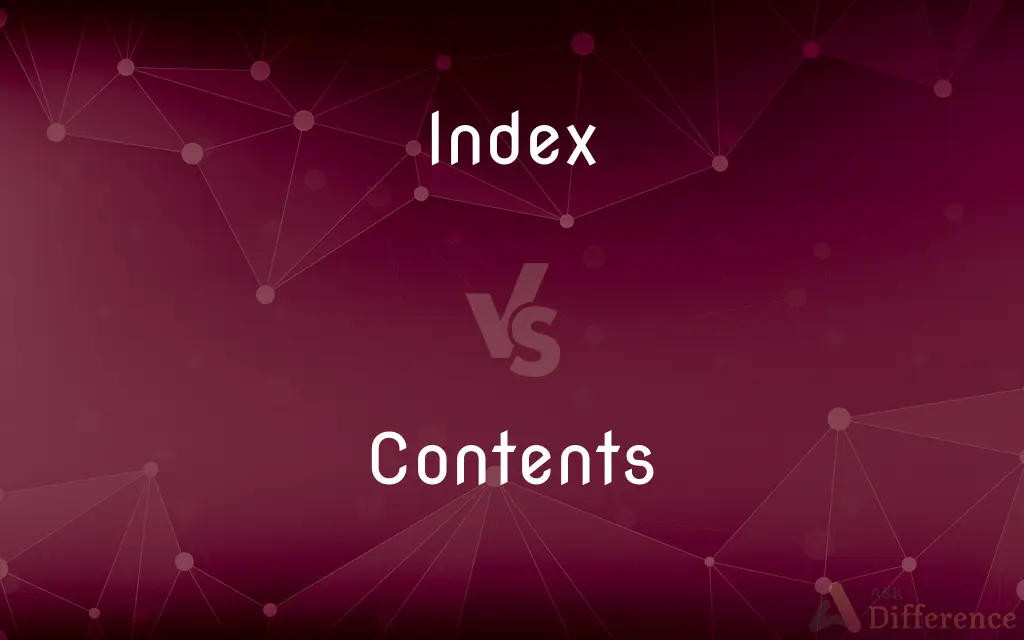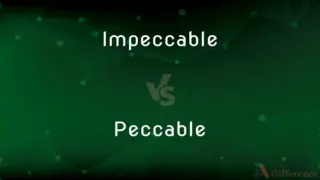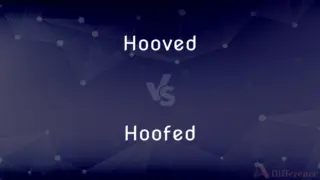Index vs. Contents — What's the Difference?
Edited by Tayyaba Rehman — By Maham Liaqat — Updated on March 30, 2024
An index is a list of terms and topics in a document with page numbers, while a contents page outlines the main sections and their starting pages.

Difference Between Index and Contents
Table of Contents
ADVERTISEMENT
Key Differences
An index, typically found at the end of a book, is an alphabetical listing of names, places, subjects, and concepts with page numbers where they are discussed. This allows readers to locate information quickly. On the other hand, a table of contents is usually located at the beginning of a document and provides a structured list of the chapters, sections, and sometimes subsections along with the pages where they start, offering a roadmap of the document’s structure.
Indexes are detailed and comprehensive, including a wide array of topics and subtopics covered in the text. They are especially useful for reference works and non-linear reading. In contrast, the table of contents offers a high-level overview of the document's organization, making it ideal for getting a sense of the overall structure and flow.
While an index is meticulously compiled by the author, editor, or a professional indexer to include nuanced entries reflecting the content's depth, a table of contents is more straightforward, outlining the primary and secondary headings as they appear in the document. This difference highlights the index's role in detailed navigation versus the table of contents' role in general orientation.
Indexes may also include cross-references, directing readers to related topics for a more comprehensive understanding, whereas the table of contents is static, presenting the information hierarchy without additional context or connections.
The creation of an index is a detailed process that involves analyzing the document's content to identify significant terms and their relationships, a task requiring human judgment and familiarity with the subject matter. Conversely, generating a table of contents can be automated in many word processing software, based on the document’s formatting styles.
ADVERTISEMENT
Comparison Chart
Location in Document
At the end
At the beginning
Function
Helps find specific information quickly by listing topics alphabetically with page numbers
Outlines the main sections/chapters and their start pages
Detail Level
Detailed, including a wide range of topics and subtopics
High-level, focusing on chapters and main sections
Use Case
Reference and non-linear reading
Understanding the document’s structure and flow
Creation Process
Requires human judgment and understanding of the content
Can be automated based on document formatting
Compare with Definitions
Index
An alphabetical arrangement for easy topic location.
I used the index to find all mentions of quantum mechanics.
Contents
Provides an overview of the document’s layout.
The table of contents revealed an unexpected chapter on ethics.
Index
A list of terms found in a document, associated with page numbers.
The book's index listed photosynthesis on page 58.
Contents
An outline of a document’s structure by chapter or section.
The table of contents showed three main parts of the thesis.
Index
Often includes names, places, and subjects.
The novel’s index included character names for quick reference.
Contents
Located at the beginning of documents.
I checked the table of contents to find the introduction.
Index
Can contain cross-references to related topics.
The index entry for bread also suggested see also: baking.
Contents
Lists titles and starting pages of sections.
The report's table of contents listed the methodology on page 10.
Index
A tool for detailed navigation within complex documents.
The index made it easy to reference specific data charts.
Contents
Helps in navigating the general structure of a text.
Thanks to the table of contents, I quickly found the chapter summaries.
Index
An alphabetized list of names, places, and subjects treated in a printed work, giving the page or pages on which each item is mentioned.
Contents
Often contents Something contained, as in a receptacle
The contents of my desk drawer.
The contents of an aerosol can.
Index
A thumb index.
Contents
The individual items or topics that are dealt with in a publication or document
A table of contents.
Index
A table, file, or catalog.
Contents
The material, including text and images, that constitutes a publication or document.
Index
(Computers) A list of keywords associated with a record or document, used especially as an aid in searching for information.
Contents
The substance or significance of a written work, especially as contrasted with its form.
Index
Something that reveals or indicates; a sign
"Her face ... was a fair index to her disposition" (Samuel Butler).
Contents
Information, such as text, video, and sound, usually as contrasted with its format of presentation
A television producer looking for content that was more entertaining.
Index
A character (☞) used in printing to call attention to a particular paragraph or section. Also called hand.
Contents
The proportion of a specified substance
Eggs have a high protein content.
Index
An indicator or pointer, as on a scientific instrument.
Contents
Contentment; satisfaction.
Index
(Mathematics) A number or symbol, often written as a subscript or superscript to a mathematical expression, that indicates an operation to be performed, an ordering relation, or a use of the associated expression.
Contents
Desiring no more than what one has; satisfied.
Index
A number derived from a formula, used to characterize a set of data.
Contents
Ready to accept or acquiesce; willing
She was content to step down after four years as chief executive.
Index
A statistical value that represents the price or value of an aggregate of goods, services, wages, or other measurable quantities in comparison with a reference number for a previous period of time.
Contents
To make content or satisfied
Contented himself with one piece of cake.
Index
A number that represents the change in price or value of stocks or other securities in a particular market, sector, or asset class.
Contents
Plural of content
Index
The stocks or other securities represented by an index.
Contents
That which is contained.
It is not covered in your homeowner's policy. You need contents insurance.
The contents of the cup had a familiar aroma.
Index
Index Roman Catholic Church A list formerly published by Church authority, restricting or forbidding the reading of certain books.
Contents
(pluralonly) A table of contents, a list of chapters, etc. in a book, and the page numbers on which they start.
I always start a book by reading the dustjacket and the contents before I really dig in to the content itself.
Index
To furnish with an index
Index a book.
Contents
A list of divisions (chapters or articles) and the pages on which they start
Index
To enter in an index.
Index
To indicate or signal.
Index
To adjust through indexation.
Index
An alphabetical listing of items and their location.
The index of a book lists words or expressions and the pages of the book upon which they are to be found.
Index
The index finger; the forefinger.
Index
A movable finger on a gauge, scale, etc.
Index
(typography) A symbol resembling a pointing hand, used to direct particular attention to a note or paragraph.
Index
That which points out; that which shows, indicates, manifests, or discloses.
Index
A sign; an indication; a token.
Index
(linguistics) A type of noun where the meaning of the form changes with respect to the context; e.g., 'Today's newspaper' is an indexical form since its referent will differ depending on the context. See also icon and symbol.
Index
(economics) A single number calculated from an array of prices or of quantities.
Index
(science) A number representing a property or ratio; a coefficient.
Index
(mathematics) A raised suffix indicating a power.
Index
An integer or other key indicating the location of data, e.g. within an array, vector, database table, associative array, or hash table.
Index
A data structure that improves the performance of operations on a table.
Index
(obsolete) A prologue indicating what follows.
Index
(transitive) To arrange an index for something, especially a long text.
MySQL does not index short words and common words.
Index
To inventory; to take stock.
Index
To normalise in order to account for inflation; to correct for inflation by linking to a price index in order to maintain real levels.
Index
To measure by an associated value.
Index
To be indexical for (some situation or state of affairs); to indicate.
Index
(computing) To access a value in a data container by an index.
Index
That which points out; that which shows, indicates, manifests, or discloses; as, the increasing unemployment rate is an index of how much the economy has slowed.
Tastes are the indexes of the different qualities of plants.
Index
That which guides, points out, informs, or directs; a pointer or a hand that directs to anything, as the hand of a watch, a movable finger or other form of pointer on a gauge, scale, or other graduated instrument.
Index
A table for facilitating reference to topics, names, and the like, in a book, usually giving the page on which a particular word or topic may be found; - usually alphabetical in arrangement, and printed at the end of the volume. Typically found only in non-fiction books.
Index
A prologue indicating what follows.
Index
The second finger, that next to the pollex (thumb), in the manus, or hand; the forefinger; index finger.
Index
The figure or letter which shows the power or root of a quantity; the exponent.
Index
The ratio, or formula expressing the ratio, of one dimension of a thing to another dimension; as, the vertical index of the cranium.
Index
A number providing a measure of some quantity derived by a formula, usually a form of averaging, from multiple quantities; - used mostly in economics; as, the index of leading indicators; the index of industrial production; the consumer price index. See, for example, the consumer price index.
Index
A file containing a table with the addresses of data items, arranged for rapid and convenient search for the addresses.
Index
A number which serves as a label for a data item and also represents the address of a data item within a table or array.
Index
The Index prohibitorius, a catalogue of books which are forbidden by the church to be read; also called Index of forbidden books and Index Librorum Prohibitorum.
Index
To provide with an index or table of references; to put into an index; as, to index a book, or its contents.
Index
To adjust (wages, prices, taxes, etc.) automatically so as to compensate for changes in prices, usually as measured by the consumer price index or other economic measure. Its purpose is usually to copensate for inflation.
Index
To insert (a word, name, file folder, etc.) into an index or into an indexed arrangement; as, to index a contract under its date of signing.
Index
A numerical scale used to compare variables with one another or with some reference number
Index
A number or ratio (a value on a scale of measurement) derived from a series of observed facts; can reveal relative changes as a function of time
Index
A mathematical notation indicating the number of times a quantity is multiplied by itself
Index
An alphabetical listing of names and topics along with page numbers where they are discussed
Index
The finger next to the thumb
Index
List in an index
Index
Provide with an index;
Index the book
Index
Adjust through indexation;
The government indexes wages and prices
Common Curiosities
How does a table of contents differ from an index?
A table of contents outlines the main sections and their starting pages at the beginning of a document, while an index lists topics alphabetically at the end with page numbers.
Can a document have both an index and a table of contents?
Yes, most comprehensive books and documents include both to help readers navigate the structure and specific contents.
What is an index in a book?
An index is a detailed list at the end of a book, providing page numbers for terms, names, and concepts mentioned throughout the text.
Do all books have an index?
Not all books have an index; it is more common in non-fiction and reference books where quick access to specific information is valuable.
What can be found in a table of contents?
A table of contents lists the titles of chapters, sections, and sometimes subsections along with their starting pages.
How is an index created?
Creating an index involves analyzing the document’s content to identify and list significant terms and their page numbers, a process that requires human judgment and familiarity with the subject.
How do indexes and tables of contents improve readability?
They enhance readability by providing structured ways to navigate a document, either through a detailed search (index) or an overview of its organization (table of contents).
Is the table of contents detailed?
The table of contents provides a high-level overview of the document’s structure, focusing on chapters and main sections rather than detailed topics.
Why is an index important in a book?
An index allows readers to find specific information quickly, enhancing the book's utility as a reference.
Can the creation of an index be automated?
While there are tools to assist in indexing, the process typically requires human judgment to ensure accuracy and relevance.
How does a table of contents aid in document navigation?
It provides a snapshot of the document’s layout, allowing readers to jump to sections of interest quickly.
What is the primary purpose of an index?
The primary purpose of an index is to enable quick access to specific information within a document by listing key terms and their page numbers.
Are indexes only found in books?
No, indexes can also be found in long reports, manuals, and academic papers, wherever detailed navigation is helpful.
Why might a document lack an index?
Creating an index is time-consuming and may not be necessary for shorter or less complex documents.
What makes a good table of contents?
A good table of contents clearly outlines the document’s structure, is easy to understand, and accurately reflects the content.
Share Your Discovery

Previous Comparison
Impeccable vs. Peccable
Next Comparison
Hooved vs. HoofedAuthor Spotlight
Written by
Maham LiaqatEdited by
Tayyaba RehmanTayyaba Rehman is a distinguished writer, currently serving as a primary contributor to askdifference.com. As a researcher in semantics and etymology, Tayyaba's passion for the complexity of languages and their distinctions has found a perfect home on the platform. Tayyaba delves into the intricacies of language, distinguishing between commonly confused words and phrases, thereby providing clarity for readers worldwide.














































